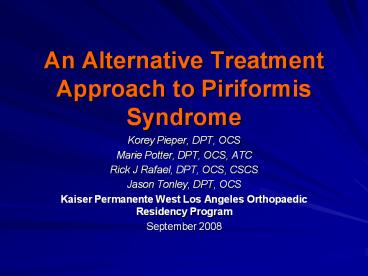An Alternative Treatment Approach to Piriformis Syndrome - PowerPoint PPT Presentation
1 / 25
Title:
An Alternative Treatment Approach to Piriformis Syndrome
Description:
An Alternative Treatment Approach to Piriformis Syndrome Korey Pieper, DPT, OCS Marie Potter, DPT, OCS, ATC Rick J Rafael, DPT, OCS, CSCS Jason Tonley, DPT, OCS – PowerPoint PPT presentation
Number of Views:366
Avg rating:3.0/5.0
Title: An Alternative Treatment Approach to Piriformis Syndrome
1
An Alternative Treatment Approach to Piriformis
Syndrome
- Korey Pieper, DPT, OCS
- Marie Potter, DPT, OCS, ATC
- Rick J Rafael, DPT, OCS, CSCS
- Jason Tonley, DPT, OCS
- Kaiser Permanente West Los Angeles Orthopaedic
Residency Program - September 2008
2
Piriformis SyndromeDefined
- Neuritis of the branches of the sciatic nerve,
caused by pressure of an injured or irritated
piriformis muscle1.
3
Symptoms
- Radiating pain from the low back down over the
sacrum into the buttocks and hip region, as well
as down the posterior portion of the upper leg to
the popliteal region1.
Image from bp1.blogger.com
4
Anatomy
image from www.tpmassageball.com
5
Possible Causes of Piriformis Syndrome
- Anatomical variation
- L/S dysfunction
- Muscle tightness and/or spasm
- Overuse
- Post surgical injury
- SIJ dysfunction
- Trauma/fall
6
Differential Diagnosis
- Differential Diagnosis of Hip pain7,8
- Intra-articular Extra-articular (Often Managed
Operatively) - Labral Tears
- Loose Bodies
- Femoroacetabular Impingement (FAI)
- Hypermobility
- Capsular Laxity
- Ligamentum Teres Tear
- Chondral Damage
- Snapping Hip Syndrome
- IT Band Syndrome
- Greater Trochanteric Bursitis
- Gluteal Tendon Injury
7
Differential Diagnosis
- Differential Diagnosis of Hip pain7,8
- Extra-articular Causes (Often Managed
Non-Operatively) - Femoral Neck Stress Fracture
- Adductor Strain
- Piriformis Syndrome
- Sacroiliac Joint Syndrome
- Tendonitis (hip flexors, abductors, adductors)
8
Differential Diagnosis
- Other Competing Diagnosis
- Lumbar Facet Syndrome
- Lumbar Disc Herniation
- Nerve entrapment
- Ischial Tuberosity Bursitis
- Lumbar radiculopathy
- Spinal stenosis
- Spondylolisthesis
- Osteoarthritis
9
Common Treatment Options
- Treatment Options2,3,4,5,6
- Injections
- L/S stabilization exercises
- Mobilization/manipulation L/S
- Mobilization/manipulation SI joint
- Foot orthotics
- Soft tissue mobilization
- Strengthening
- Stretching
- Surgical / arthroscopic release
- Ultrasound
-
10
Common assumption guidingtreatment approaches
- The piriformis is shortened or in spasm and is
compressing the sciatic nerve
11
Purpose of study
- To create a case series using an alternative
treatment approach to piriformis syndrome
12
Inclusion Criteria Objective Exam
- Unilateral pain from lower lumbar/buttock region
to the leg - Symptoms not reproduced from lumbar, SI joint,
and/or hip joint examinations
13
Inclusion Criteria Objective Exam
- Lumbar Exam
- Negative AROM with OP
- Negative PA exam
- Neurological testing negative for nerve root
lesion - SIJ Exam
- Negative cluster
- Hip Exam
- Negative ROM, excluding quadrant
14
Inclusion Criteria Objective Exam
- Reproduction of symptoms with
- Palpation of piriformis muscle
- Piriformis stretch test
- FAIR Test
- Demonstrates movement dysfunction of ADD and/or
IR and reproduction of symptoms with step down
test - Decreased reproduction of symptoms with corrected
movement during step down test
15
Objective Exam
- Patient to fill out disability questionnaires
- Oswestry Disability Index
- Lower Extremity Functional Scale
16
Treatment Approach
- Isolated strengthening for hip extensors,
abductors, and external rotators - Functional movement re-education for decreasing
hip adduction and internal rotation - NO!!!!!
- Stretching
- Soft tissue massage
- Modalities
17
Treatment Approach Examples
- Hip strengthening
- Clams
- Bridging
- Prone hip extension
- Quadruped hip extension
- Hip abduction
18
Treatment Approach Examples
- Movement Re-education
- Postural correction
- Sit to stand transitions
- Single leg sit to stands
- Lunges
- Plyometrics if indicated
19
Patient Data
- 7 Patients
- Age mean 56 (range 31 - 69)
- Duration of symptoms 197 days (range 45
730) - of visits 5 (range 2-8)
- Duration of visits 9 weeks (range 3-16)
20
Average LE Functional Scale
Range initial (37-70) discharge
(54-80)
21
Average VAS (Pain Scale)
Range initial (6-10/10) discharge
(0-4/10)
22
Analysis
- Movement assessment allowed proper physical
therapy diagnosis and treatment - Patients can have multiple positive tests, but
movement reproduces primary pain complaint - Ceiling effect of questionnaires affects data
analysis
23
Future Research
- Prevalence of movement dysfunction in patients
diagnosed with piriformis syndrome - Most effective treatment modality for movement
dysfunction strength training vs. movement
re-education
24
Conclusion
- Movement re-education and strengthening can be a
successful way to treat piriformis syndrome when
a patient presents with a coordination deficit.
25
References
- Edwards, F.O. Piriformis syndrome. Academy of
Applied Osteopathy. Yearbook, 1962, pp 39-41. - Parizale JR, Hudgins TH, Fishman LM The
Piriformis Syndrome. Am J. Orthrop,
199625819-823. - Parizale JR, Hudgins TH, Fishman LM The
Piriformis Syndrome A Review. Paper. The. Am J
of Orthop. 2002251-11 - Bird JW Piriformis Syndrome. Oper Tech Sports
Med 2005 13 71-79 - Mayrand N, Fortin J, Descarreaux M, Normand MC.
Diagnosis and management of posttraumatic
piriformis syndrome a case study. J.
Manipulative Physiol Ther. 2006
Jul-Aug29(6)486-91 - Keskula DR, Tamburello M Conservative Management
of Piriformis. Syndrome. J Athl Train. 1992
27(2)102, 104, 106-107, 110 - Lisa M Tibor, Jon Sekiya. Differential Diagnosis
of Pain Around the Hip Joint. The Journal of
Arthroscopic and Related Surgery. 2008191-15 - Michael K Shindle, Benjamin G Domb, Bryan T
Kelly. Hip and Pelvic Problems in Athletes. Oper
Tech Sports Med. 2007 15 195-203.































